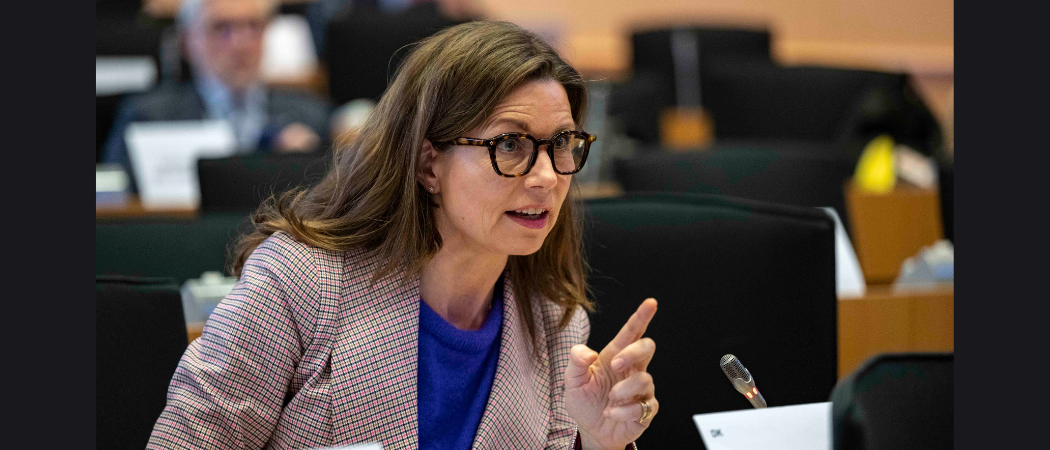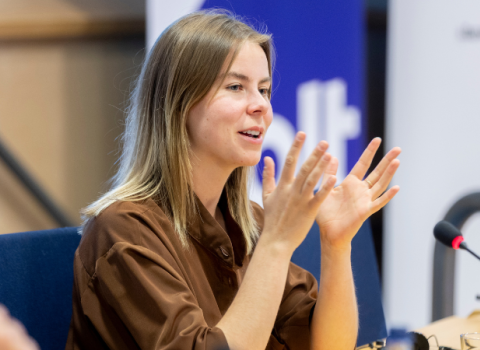Without textiles, there is no fashion. But textile manufacturing is highly polluting and there is an urgent need to make it sustainable. The industry and EU policymakers must work together on harmonising different national rules to turn Europe’s catwalks green

MEP Pernille Weiss. Photo: Emilie Gomez / European Union
In silver-grey sequined trousers by Danish designer Stine Goya, I sat in the front row at the Copenhagen Fashion week, invited as the only Danish MEP to be a negotiator on the EU strategy for sustainable textiles. The show was about classic fashion, but there is also something else going on in the industry right now, as it becomes aware that EU politicians are at risk of making a lot of noise but formulating the wrong policies if the industry and the legislators do not communicate more with each other.
Only 1% of all clothes produced are recycled, and that is simply not good enough. But unlike other sectors with a large carbon footprint, such as steel and cement, the textile industry has stayed under the radar when it comes to sustainability and is not participating in the green transition. Its washing, scouring and dyeing processes are acknowledged to very harmful to the environment. It continues to use too much water, too many chemicals and techniques that are too energy-intensive.
At the same time, there is not enough understanding of how to clean up manufacturing and pivot the industry to fabrics that can be recycled through the supply chain, to achieve true sustainability. Knowledge we do have in the field is pointing in different directions. This is not good enough. The textile industry needs to be given the direction and the means clean up.
The EU aims to promote change, setting out a strategy for a sustainable textiles sector in March 2022. The European members of the international fashion industry are keen to join in, and as one case in point, last month the Copenhagen Fashion Week set out its 2023 – 2025 sustainability programme, pledging amongst other objectives to promote more recycling of clothes and to decarbonise the supply chain.
As things stand, around 16 EU directives and regulations are in some way related to sustainability in the fashion world. We now need to update them, so they are fit for the future. As a conservative, I prefer carrots, but I'm not afraid to use the stick if necessary.
I want life-cycle logic to outperform greenwashing and the promotion of selected technologies that in the final bottom line of climate and environmental impact, are not much better than their alternatives. Whether it's cars or clothing, I am endlessly fed up with self-proclaimed green evangelists, who say their solution is better than others.
The principle should be that the polluter pays. The EU's internal market for textiles must not only be the most sustainable in the world but also the most attractive for the many different players in the textile industry.
Fast fashion
I don't want to interfere directly in people's everyday consumption, but I do want to make it easier to 'walk-the-talk'. Fast fashion is a problem because it promotes overproduction of textiles that are manufactured using methods with a sky high carbon footprint and which damage the environment.
Furthermore, fast fashion seems to be driven by business models in which the contribution to local socioeconomic growth in the production stage is questionable.
We already have the means to make the textile sector in the EU more sustainable. We just need to scale them up and bring them to the market. We need to use the power of the single market to deal with the 27 different national ways of handling used textiles in the member states. We need to support more research and innovation in all relevant links in the chain that make up the cradle-to-cradle journey of textiles in the circular economy.
Small entrepreneurs are often the ones with the most innovative approaches. They need to be stimulated and protected from being stifled by unnecessary rules and documentation requirements.
The big players must also be listened to. The new and more ambitious rules and frameworks have to support their competitiveness in the international market. Their competitive drive - as proud European companies - must be stimulated to move the entire global textile industry in a sustainable direction.
The regulations should aim to facilitate sustainable business models and improve the competitiveness of the sector. Many obligations increase costs for businesses. Therefore, it is very important to provide adequate funding and support for SMEs and microenterprises, so that the regulations do not overburden the drivers of innovation and new technologies. On the contrary, we need to embrace the business opportunities arising from recycling, reusing and repairing.
Research and innovation are crucial for strengthening competitiveness. We need to invest in technologies that reduce the carbon footprint of the textile sector, create more sustainable fibres and textiles, and find new ways to treat waste from the industry.
We need to ensure transparency, for instance, by implementing the Digital Product Passport. Therefore, I call for the creation of a pilot project funded by Horizon Europe. Backing this up, there should be a programme for textiles innovation in Horizon Europe. The European Innovation Council could create an EU research and innovation agenda aligned with the transition pathway for the textile ecosystem. We need to create the best circumstances for a transition to a circular industry.
The need and potential for change is great, and so are my ambitions. I share this starting point with my colleagues. We must make the European textile strategy a leader in the green agenda to inspire the rest of the world.





 A unique international forum for public research organisations and companies to connect their external engagement with strategic interests around their R&D system.
A unique international forum for public research organisations and companies to connect their external engagement with strategic interests around their R&D system.